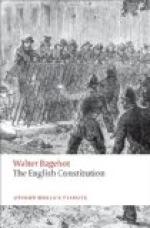The best possible commentary on these remarks is the history of English history. It has not been sufficiently remarked that a change has taken place in the structure of our society exactly analogous to the change in our polity. A Republic has insinuated itself beneath the folds of a Monarchy. Charles II. was really the head of society; Whitehall, in his time, was the centre of the best talk, the best fashion, and the most curious love affairs of the age. He did not contribute good morality to society, but he set an example of infinite agreeableness. He concentrated around him all the light part of the high world of London, and London concentrated around it all the light part of the high world of England. The Court was the focus where everything fascinating gathered, and where everything exciting centred. Whitehall was an unequalled club, with female society of a very clever and sharp sort superadded. All this, as we know, is now altered. Buckingham Palace is as unlike a club as any place is likely to be. The Court is a separate part, which stands aloof from the rest of the London world, and which has but slender relations with the more amusing part of it. The first two Georges were men ignorant of English, and wholly unfit to guide and lead English society. They both preferred one or two German ladies of bad character to all else in London. George III. had no social vices, but he had no social pleasures. He was a family man, and a man of business, and sincerely preferred a leg of mutton and turnips after a good day’s work, to the best fashion and the most exciting talk. In consequence, society in London, though still in form under the domination of a Court, assumed in fact its natural and oligarchical structure. It, too, has become an “upper ten thousand”; it is no more monarchical in fact than the society of New York. Great ladies give the tone to it with little reference to the particular Court world. The peculiarly masculine world of the clubs and their neighbourhood has no more to do in daily life with Buckingham Palace than with the Tuileries. Formal ceremonies of presentation and attendance are retained. The names of levee and drawing-room still sustain the memory of the time when the king’s bed-chamber and the queen’s “withdrawing room” were the centres of London life, but they no longer make a part of social enjoyment: they are a sort of ritual in which nowadays almost every decent person can if he likes take part. Even Court balls, where pleasure is at least supposed to be possible, are lost in a London July. Careful observers have long perceived this, but it was made palpable to every one by the death of the Prince Consort. Since then the Court has been always in a state of suspended animation, and for a time it was quite annihilated. But everything went on as usual. A few people who had no daughters and little money made it an excuse to give fewer parties, and if very poor, stayed in the country, but upon the whole the difference was not perceptible. The queen bee was taken away, but the hive went on.




